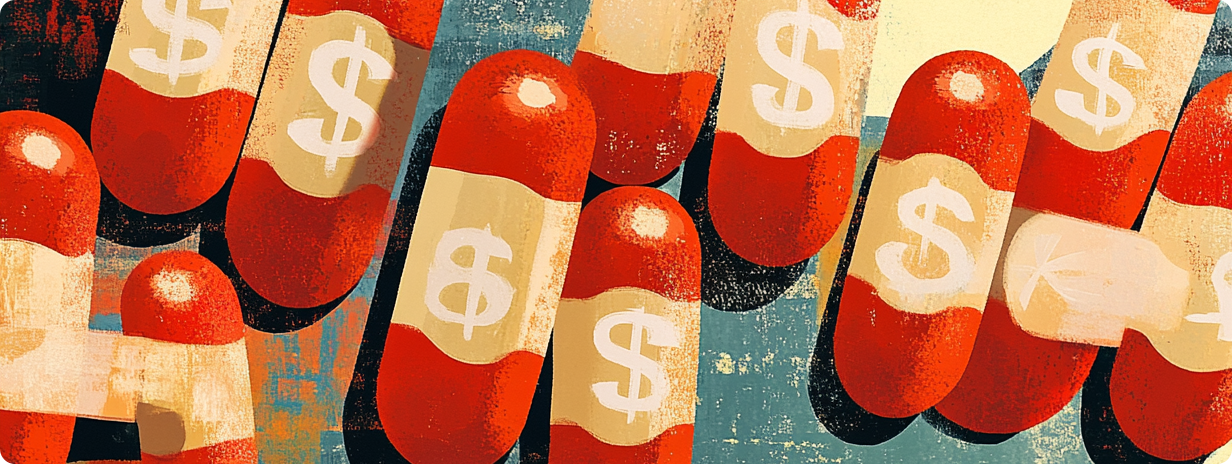There’s something inherently jarring about a price tag with a comma in it, especially when it’s followed by six zeroes and attached to a single dose of medicine. Understandably, people flinch.
One-time gene therapies often cost $1 million or more, and that’s before lifetime monitoring, patient support and follow-up visits. Yet these therapies often replace decades of chronic care. A patient who would otherwise need daily pills, monthly transfusions or regular hospital stays suddenly… doesn’t. The cost isn’t just for a vial of engineered virus or some CRISPR’d cells; it’s for never needing all that other stuff again.
Zolgensma, a gene therapy that treats spinal muscular atrophy, costs $2.1 million for a single infusion. Spinraza, another treatment for SMA, costs $750,000 in year one and $375,000 every year after. By year five, Spinraza would surpass Zolgensma in total spend and Spinraza doesn’t cure anything. It just slows decline.
Zolgensma might be shockingly expensive. But if you’re thinking in actuarial terms, it may be a bargain.
Tiny Populations, Huge Implications
Here’s the kicker: These expensive therapies aren’t what’s breaking the system. Orphan drugs, those developed to treat rare diseases, make up approximately 11% of U.S. drug spending. Meanwhile, the lion’s share of spend goes toward the treatment of conditions like diabetes, heart disease and cancer.
This creates an asymmetric problem. Cutting orphan drug prices won’t significantly lower overall healthcare costs, but it will wreck incentives to create treatments for people with rare, and often fatal, conditions. You know, the ones nobody used to make drugs for, because the economics didn’t work.
Which brings us to a sobering reality: The current system is a moral kludge, but it also occasionally produces miracles.
Most Drugs Fail—And That’s Why the One That Worked Is So Expensive
Let’s pause and do some basic math. According to a 2022 study from the University of Michigan’s College of Pharmacy, only one in 10 drugs that enter clinical trials actually make it to market. That means for every Zolgensma, there are nine failed candidates—most of which cost millions. Drug pricing, then, is less about how much it costs to manufacture a drug and more about how much it cost to develop it in the first place.
Now scale this problem down to rare diseases. Clinical trials for rare conditions require global patient recruitment, boutique manufacturing and hyperspecific regulatory paths, all of which drive up per-patient costs. You can’t amortize your R&D over millions of users, because you’re lucky if you have thousands. Sometimes you have dozens.
So while million-dollar price tags may seem like profiteering at first glance, they appear more justified when viewed through the lens of statistical attrition and fixed costs in a high-risk market.
What happens if payers manage to bring down the price of these ultra-expensive medicines? That may make it easier for more payers to cover them, and for more patients to receive care. But we’re also betting that companies will keep rolling the dice on therapies like these, even when the payoff disappears.
Ultimately, if we force those prices down too far, we may not just make these medicines cheaper. We may make them vanish.
The Real Problem: Misaligned Time Horizons
Payers don’t hate these therapies because they’re ineffective. On the contrary, many are clinically better and cheaper in the long run. The problem is that they can be financially devastating in the short term.
Imagine running a state Medicaid program. You’ve budgeted a certain sum for this year. Suddenly a new gene therapy is approved and a single patient becomes eligible. The cost? $2 million.
You can’t immediately raise taxes to cover that. You’re now over budget and possibly in the political crosshairs. And who’s to say that the patient won’t switch to another insurer next week or month or year?
Welcome to the cash-flow mismatch problem: The payer who buys the cure might not be the one who benefits from it.
This is why many payers seem to prefer older, less effective chronic therapies. Those therapies spread the cost of care more predictably over time and, as a result, don’t threaten annual budgets. Perversely, they make short-term financial sense even in situations when they don’t make long-term financial sense, or even clinical sense.
Solutions That Aren’t Terrible
So what do we do? We get clever, that’s what. The pharmaceutical world is quietly experimenting with payment models that decouple cost from time.
Outcomes-based rebates: If the cure doesn’t work, you get your money back. This aligns incentives and makes the therapy less of a gamble. The challenge is defining what “work” means, especially for long-term outcomes.
Amortized payments: You pay over time, like a mortgage. Five-year payment plans were offered for Zolgensma. This doesn’t reduce the cost, but it makes the cost tolerable. But what if the patient switches insurers mid-contract?
Subscription models: This would take the form of a flat fee for unlimited access—think Netflix, but for life-saving treatments. Louisiana used this for Hep-C cures. It could work for gene therapies too, especially in closed systems like Medicaid.
Each of these solutions has flaws. But they’re all better than “deny coverage because it’s too expensive this year.”
There are other solution pathways as well, including more efficient R&D (and AI could play a major role here). But when it comes to the high price of R&D, and the correspondingly high price of treatments for the rarest of diseases, the future may require some clever financial engineering.
If You Want Miracles, You Have to Fund Them
The weird truth about healthcare economics is that almost no one wants to pay for a cure up front, even when it’s cheaper than paying for disease over time. Our system is optimized for chronicity, not finality. It pays for insulin but balks at beta cell regeneration; it funds dialysis but hesitates at gene editing. This is not a failure of science. It’s a failure of accounting.
If we want to live in a world where rare diseases get cured, we have to build financial systems that make curing people economically viable. That might mean amortization laws or public reinsurance pools. It definitely means not treating rare disease innovation like the villain of the healthcare budget.
The uncomfortable reality is this: The price of innovation is paid by the success that follows it. If we’re not willing to cover that price—fully, honestly and with a long-term perspective—then we’re also not willing to live in a world where cures are possible.
And we probably shouldn’t pretend otherwise.
Are miracle drugs going to break the healthcare system, or save it? Drop us a note at hello@kinara.co, join the conversation on X (@KinaraBio) and subscribe on the website to receive Kinara content.



